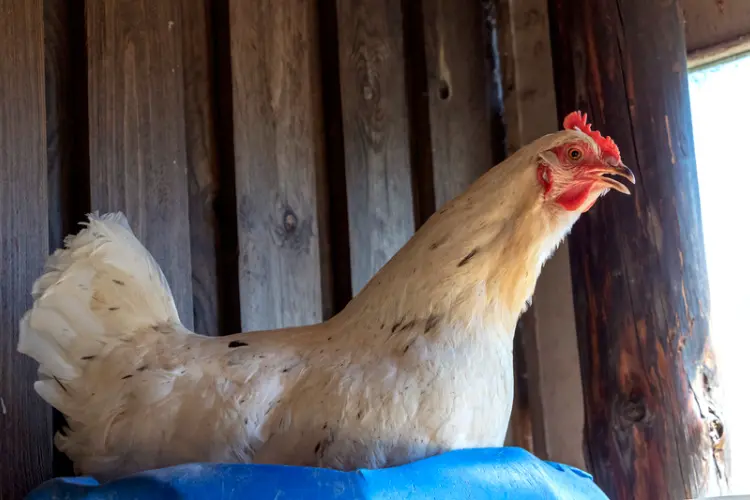How Many Eggs Does A Chicken Lay A Day
Many poultry farmers and backyard chicken enthusiasts face a common, perplexing issue – understanding and predicting the egg-laying capacity of their chickens.
Varying numbers of eggs laid by different breeds, each chicken’s individual health and age, and the impact of seasonal changes make the matter complex. Such uncertainties can lead to economic inefficiencies and undermine efforts to sustainably manage poultry.
Our guide about how many eggs does a chicken lay a day aims to address these by providing scientifically-based insights and practical tips to maximize your hens’ egg production potential and optimize your poultry management techniques.
What Is the Highest Number of Eggs a Hen Can Lay in a Day?
A hen can only lay a maximum of one egg per day. However, egg-laying isn’t guaranteed to happen daily. The egg production process in a hen takes about 24 to 26 hours, which explains this interval.
Intriguingly, light plays a significant role in a hen’s egg-laying cycle. The lengthening days of spring and summer naturally stimulate a hen to begin producing eggs. In contrast, as days start getting shorter with the arrival of fall and winter, the hen will gradually cease to lay eggs.
To ensure year-round egg production, hens should be exposed to a constant amount of light each day, ideally around 14 hours of light and 10 hours of dark. If your chickens are free-ranging outdoors, they may require supplemental light during the morning or evening hours to ensure they receive the optimal light. This will prevent the hens from discontinuing egg-laying.
Factors Affecting How Many Eggs Does A Chicken Lay A Day
The Influence of Breed on Egg Laying
Chicken breeds greatly vary in their egg-laying capacity. On the one hand, we have commercial layers like White Leghorns, ISA Browns, and Rhode Island Reds, renowned for their high egg production.
Specifically bred for this trait, these breeds can lay an egg almost daily, resulting in an impressive annual tally of around 280 to 320 eggs. These high performers are ideally suited for those whose primary interest is maximizing egg production.

On the other hand, heritage or rare breeds like the Sussex, Orpington, and Plymouth Rock offer a more modest yield of about 150 to 200 eggs annually. Such breeds were developed considering a balance of various traits like egg-laying, meat production, foraging ability, and appearance.
The choice of breed is pivotal, as it should align with your egg production expectations and specific poultry-keeping goals. The breed’s influence on egg-laying capacity illustrates the significant diversity within the poultry world. So, when you’re determining how many chickens you need for egg production, it depends on the breed.
Impact of Age on Egg Production
Age indeed plays a central role in determining a hen’s egg-laying productivity. The journey of a hen’s egg production essentially starts when it reaches sexual maturity, typically around 5-7 months of age. However, the exact onset of laying eggs can depend on the breed and the individual bird, along with environmental factors such as light exposure and diet.
After commencing egg laying, hens experience a period of peak production, usually occurring when they are between 7-10 months old. During this peak period, especially in commercial breeds, it’s not uncommon for hens to lay an egg almost daily.
However, as the adage goes, ‘all good things must come to an end’, and this peak egg production period is no exception. After reaching the age of 2-3 years, a hen’s egg-laying prowess begins to wane.
This gradual decline continues as the hen ages, with a noticeable drop-off in most hens by the time they are 4-5 years old. Some hens may continue to lay past this age, but the frequency will be considerably less than during their prime..
The Role of Diet in Egg Laying
Nutrition is a key determinant in a hen’s ability to lay eggs. Chickens require a diet well-rounded with proteins, vitamins, and minerals to sustain consistent egg production. Proteins are particularly crucial as they are the primary building blocks for egg production.
Calcium and vitamin D, classified as minerals and vitamins, respectively, are necessary for eggshell formation. A deficient diet can hinder the egg-laying process, leading to fewer eggs and potentially impacting egg quality. Regular access to clean water is also vital since a large part of the egg is water.
Read also: What Do Chickens Eat – 201 things on our list

Impact of Stress on Egg Production
Chickens are highly sensitive to their environment, and high-stress levels can significantly impede egg production. Stressors can range from changes in the environment, the presence of predators, and diseases, to harsh weather conditions.
Even minor alterations in their routine can cause stress in chickens, which may result in reduced egg-laying or complete cessation in some cases. Therefore, maintaining a consistent and safe environment is crucial for optimal egg production..
Light Exposure and its Effects on Egg Laying
Exposure to light can affect how chickens lay eggs. This is due to a gland in the hen’s brain that responds to light and triggers egg production. To maintain optimal egg-laying, hens require approximately 14 hours of light each day.
As daylight hours decrease during the winter and fall, a hen’s egg production can slow or cease completely. Supplemental lighting in the coop can help maintain egg production during these shorter daylight periods..
Health and Egg Production
A hen’s health status greatly affects its egg-laying performance. Healthy hens tend to lay more consistently, while those plagued with diseases, parasites, or other health issues will likely experience a drop in egg production or lay fewer eggs.
Molting and Its Impact on Egg Laying
Molting is a natural process in chickens where they remove their old feathers and grow new ones. During the molting period, typically once a year, egg production significantly slows down or may even stop entirely.
Broodiness and Egg Laying
Broodiness, the instinct to hatch eggs, can also affect a hen’s egg-laying frequency. When a hen becomes broody, she stops laying new eggs and instead focuses on incubating the ones she has already laid. Certain breeds are more prone to broodiness than others, and a broody hen can be a challenge if egg production is your main goal.
If you’re planning on hatching and raising chicks, whether through broody hens or incubators, having the right equipment and knowledge is crucial. Dive into our The Best Chick Brooder Guide: 2023’s Hot Picks Revealed for insights on the top chick brooders available this year.

Living Conditions Affecting Egg Production
Lastly, the conditions in which hens live can significantly affect their egg production. Factors such as overcrowding, lack of cleanliness, insufficient access to fresh water, or lack of suitable nesting spaces can cause stress and thereby negatively impact egg-laying. Providing hens with a spacious, clean, and comfortable environment can ensure they lay eggs consistently.
FAQ
Is it possible for a hen to lay 2 eggs a day?
While it’s extremely rare, a hen can technically lay two eggs a day. This typically happens when the hen’s ovulation cycle is accelerated. However, it’s not a sustainable phenomenon and might occur once or twice in a hen’s lifetime.
What time do hens lay eggs?
Hens typically lay eggs within a few hours after sunrise, often between 5-6 hours. However, the exact timing can vary from hen to hen and from day to day, as it’s influenced by factors such as the hen’s individual laying cycle and environmental conditions.
How to increase your chicken’s egg production
To maximize your chicken’s egg production, ensure they receive a well-balanced diet of proteins, vitamins, and minerals. Maintain a consistent light exposure of about 14 hours per day, keep stress levels minimal, and provide a clean and spacious living environment. Regular health checks and prompt treatment of any ailments are also vital.
What is the best breed of chicken for eggs?
For pure egg-laying ability, commercial breeds like White Leghorns are considered some of the best. They can lay approximately 280 to 320 brown eggs per year. Other prolific egg layers include Rhode Island Reds and ISA Browns. However, the “best” breed can depend on your specific needs, whether that’s egg quantity, egg size, egg color like green eggs, or a balance between egg-laying and other traits.
Summary: How Many Eggs Does A Chicken Lay In A Day
The number of eggs a chicken lays daily is a multifaceted equation influenced by various factors, including breed, age, diet, stress, light exposure, health, molting, broodiness, and living conditions. Even though high egg-laying breeds can lay nearly an egg per day at their peak, it’s essential to remember that chickens are living beings with their own rhythms and requirements.
By providing a balanced diet, managing stress levels, ensuring adequate light exposure, maintaining optimal health, and creating a conducive living environment, we can support our hens in laying farm fresh eggs consistently. However, the joy of chicken keeping extends beyond egg collection—it’s a rewarding journey of fostering a symbiotic relationship with these remarkable creatures.





Comments are closed.